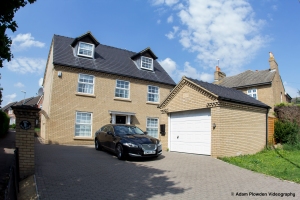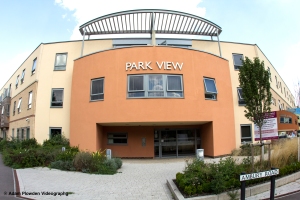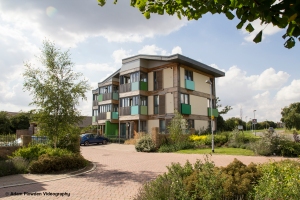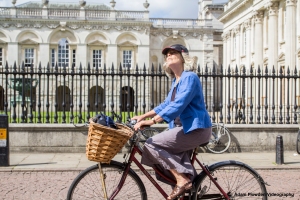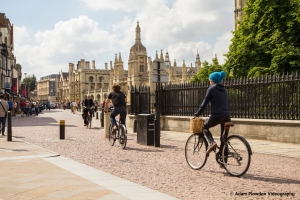Check out this incredible video, got to be one of the best of the year! Those skiers look like balls of flaming light cascading down the mountainside.. Incredible!
Todays VideoQuestions - Image Stabilization
Image stabilization, vibration control, optical stabilization or whatever you wish to call it is an -in lens- operation that reduces pan and tilt vibrations and shake that would blur the captured image. It works by using electromagnets to align a floating lens element, which corrects the shake and vibration over the two axis; left and right, up and down. Image stabilization is included in a range of lenses from manufacturers, but you will notice the heftier price tag in comparison to a non-IS version due to the extra element in the lens. I will try to clarify the importance of using IS when you're out filming, and why I use IS lenses for my work.
![ef_70-200mmf4_lusm[1]](http://ajp1991.files.wordpress.com/2014/03/ef_70-200mmf4_lusm1.jpg) The Canon 70-200mm F/4 without IS = £519
The Canon 70-200mm F/4 without IS = £519
![ef-70-200mm-f-4l-is-usm-fsl---1258b005aa[1]](http://ajp1991.files.wordpress.com/2014/03/ef-70-200mm-f-4l-is-usm-fsl-1258b005aa1.jpg) This Canon 70-200mm F/4 with IS = £894
This Canon 70-200mm F/4 with IS = £894
When choosing your camera body, tripod, mic and all of the other accessories that seem to be required for DSLR videography, one of the hardest will be choosing the right lenses for what work you would like to do, to cover a wide range of focal lengths and apertures, and how much money you want to spend. All three of those points will affect each other in your final purchase choice, but I hope to help narrow down your choices.
What will you be filming?
One key point to consider, as if you are filming live action sports you will require a different set of tools compared to model and fashion videos. Both however will benefit from at least one IS lens in your kit bag. I work in many different areas and styles of videography, so the kit I carry is an all round solution to whether I'll be at the back of a conference hall, or only centimeters away from my subject so being prepared before you know what you are shooting on the day is key - also where IS lenses come in handy!
It isn't recommended to use Image Stabilization when you are filming on a tripod as this can cause frame-by-frame jitter, where the lens attempts to correct smooth movement. But for all the times the camera is not on a steady support like a tripod, having IS will correct any major shake and blurring that occurs in the lens.
So, imagine holding the camera on a monopod with a lens and then tilting or panning. Inherently some shaking will occur from you moving the camera. Depending on your focal length or how far you have zoomed in, this will also multiply the visible blur, also remember DSLR's rolling shutter which will also be added too if you're not careful! Is that too much to think about when shooting video? Yeah it sure is. But having an IS lens will correct a good portion of the errors.
Another great example is sports, and running and gunning with the camera (wedding videography for example) where you are moving around a lot.
What focal lengths are you working with?
IS lenses come in a range of focal lengths; the standards are the 24-70 range and 70-200 range. If you are working with subjects closer to you, in the wide and portrait range, then having a 24-70mm with IS can be operated pretty well hand-held or on a monopod (I'd always recommend using at least one support method to achieve steady shots, either a tripod, monopod, rig etc). However if you are going to be further away from your subject then the longer focal length of 70-200 will work better for your needs.
The focal ranges in between the wide and telephoto can be achieved either by zooming, or by using prime lenses which traditionally do not have IS so will have more shake regardless of your mounting or grip method.
Price
You will have to pay more for an IS lens, it is an additional function that works to correct the image before it is recorded, but it is worth the cost. You may only end up purchasing one lens with IS, but I recommend choosing the lens you will use the most to future-proof your purchase.
Models of Lenses and Manufacturers
Presumably, if you are filming on a DSLR you'll have a Canon body with an EF-mount for the lenses. Canon manufacture very high quality L series lenses with IS, but if you are starting out in this game they will blow your budget immediately. 3rd party manufacturers like Sigma, Tamron, Tokina and Samyang produce incredible quality lenses too, and just because they aren't Canon doesn't mean you can't use them with the camera you have; many 3rd parties allow you to choose the correct lens mount for the camera.
I went down this route when choosing my new equipment, and after plenty of testing and research I chose the Tamron 24-70 F/2.8 VC and the Sigma 70-200 F/2.8 OS, and for me they perform outstandingly.
In many cases you will be using an APS-C size sensor camera like the 60D, 600D, 70D which also have their own range of lenses that are considerably cheaper than their full-frame brothers, some that I have worked with in the past that I can recommend are -
Budget solution - Tamron 17-50mm F/2.8 VCNext best thing if you have the money - Canon 17-55 F/2.8 IS
For a longer focal length, above 100mm you'll have to dig a little deeper in your pocket to get a good quality lens with IS. I did purchase this lens when I started, but because I purchased the NON-OS version it has pretty much been gathering dust in my bag, as at 200mm the image was too shaky and had quite a bit of chromatic aberration. Sigma 18-200 F3.5 to 6.3.. a semi pointless purchase for me, so follow this lesson!
How does using a steadicam affect the stabilization?
Good question. A steadicam is a device that counter balances the weight of the camera and lens to achieve a smooth flowing motion to movement, and takes lots of practice. Using a stabilizer won't imitate image stabilization, or make the image less shaky - so to speak. This depends on the lenses you are using, how fast you are moving and the experience of the steadicam operator. Using an IS lens on a steadicam will certainly correct shake over the two axis, but a steadicam works on 3 axis so shake and blur is inherent unless you shoot at a higher frame rate or apply stabilization correction in post production.
I tend to shoot most of my steadicam footage at 50fps, capturing double the frames which when played back in slow motion smooths out any jitter or quick movement. Shooting in slow motion is a really cool and creative tool, so it is worth playing around with, but remember you will be recording at a lower resolution of 720p, not 1080p (darn you Canon hurry up and give me this!!).
I shot the example material today, so will top and tail the clips and get them up tomorrow, so watch this space!
Conclusion
Get a lens with IS, or VC or OS as your standard, go-to lens. If you're going to use a steadicam too, having stabilization on a wide angle lens will be doubly effective and means less stabilization in post!
Review: Manfrotto Backpack50
Hello all! Here is the anticipated review of the new Manfrotto Backpack50, the flagship range of professional photography and videography bags for cameras and equipment.

The new range comes in a variety of sizes depending on the equipment and lenses you use. If you are going to be shooting for ENG, or know you will need fast access to your camera and lens kit then the Holster range may be for you, or if you're looking for a perma-home for a vast range of bodies, lenses and accessories then a Roller Bag or Backpack will be for you.
I got a great surprise through the post a couple of weeks ago, it was the Backpack50, which I have been using out on photo and video shoots, testing it to the extreme in a wide range of shooting situations such as weddings, on location video and corporate events.
First things first, as you can see the bag is BIG! Not too big that it is laborious to carry around, as the support straps provide great comfort for a fully packed bag. Having a bigger bag eliminates the need to bring extra sling bags if you take laptops and tablets on shoots, as there two separate zip pockets for both, and also allows me (predominantly shooting video) to keep all of my essentials in one place. For example, the bag is currently full with my kit needed for a shoot for Tesco on Friday, so a 7" HD field monitor, clamps, Rode VideoMic, 2x DSLR bodies and 6 lenses sit snugly in the protective separators. I have all I need in one convenient place, a perfect solution especially as I am a SINGLE shooter.
Overview of the Backpack50's features:
Unlike other camera bags which open from the side or the back, the Backpack50 opens from the top, which allowed me to quickly grab my camera (with lens attached) almost immediately with ease. If you've got the waist support done up then this is even quicker as you can swing the bag from your back to front and grab the camera that way. The other handy feature of this is that you can have a telephoto lens attached to the camera and still take it out with ease, as the support pads can be customized to fit your individual kit needs.
Here you can see the bag open, the top flap unzips all the way down revealing many side pockets, 3 zip pockets on the flap (which I use for little bits that I can grab quickly such as batteries, SD cards, hot shoe adapters etc). There is even a protected zip pocket for a tablet if you have one too!
The capacity of the Backpack50 is fantastic! As I mentioned before I filled it up with various accessories for shooting video, but it will comfortably hold a large DSLR body and telephoto lens attached in the middle section, up to 8 standard lenses in the side sections, as well as two ideally large and deep side pockets. These would be great for clamps and arms, but I use mine for my microphone and a little tool box for emergencies!
A small but memorable Manfrotto logo on the main flap of the bag, the branding is not in your face which keeps the bag discrete.
With a fully packed bag (including a laptop, EVF) it is heavy as you would expect, however the inclusion of a very comfortable, padded waist strap distributes the weight evenly through the body, rather than putting the pressure on your shoulders, reducing fatigue, and it was a welcome relief for me to see too! All the straps are padded, and are very heavy duty for a camera bag which is fantastic when shooting in rugged and fast paced environments, or for a very long time.
The Backpack50 also includes a waterproof cover, essential for protecting your beloved kit in times of heavy downpour, however it would have been better to see this built into the bag rather than a separate part, as this reduces the risk of forgetting it!! It also has a side strap for tripods which is a welcoming sight. Previously I used a Lowepro bag and simply strapped my Manfrotto 055B tripod and 701 head to the main straps, which is heavy and also puts lots of strain on the bags fastenings (i don't recommend this). The external strap loops through a heavy duty fabricated patch on the side of the bag, and the strap can be secured around the head of the tripod. It is quick release too, so you can get the tripod off the bag and set up quickly. A great improvement.
Overall, I am delighted with Manfrotto's new Backpack50 as it caters for the pro photographer AND videographer, protecting our livelihood (equipment) with fantastically engineered bag sections, as well as providing flexibility when out shooting which many backpacks restrict due to their bulky and un-ergonomic design. Manfrotto have overcome this by designing a bag with the pro in mind, and have produced a very successful and ergonomic addition to the growing kit list of photographers and videographers alike.
Check out the new range on Manfrotto's website here - http://www.manfrotto.co.uk/collection/8615.1065.17520.0.0/Professional
Axiom Modular Camera?!
What is this?!! A company called Axiom have been developing the idea of a modular camera system, which is 'open source', so you can include whatever functions or formats you wish.. Extreme thinking.. Maybe not! Axiom Open Module Concept Camera
Think of all the tech in the last 3 to 5 years that has dramatically changed the way we acquire footage; there was the DSLR 5Dmkii boom, then the Canon Cinema range, Sony FS700, F5, F55, Blackmagic Design Cinema Camera, pocket camera, production camera, Panasonic GH3 and I'm pretty sure I can carry on until this page is full, but the gist I'm getting at is that tech is developing faster and in more intricate and innovative ways.
Here is the graphic from their announcement:
Just as an example; if you have a 4K capable sensor (Sony CineAlta Range), then all it takes is a firmware upgrade to get amazing new features such as 4K raw recording and up to 120fps slow motion..
If you look at it that way, there sure is a possibility, and I know I'm definitely supporting this crowdfund!
What I've Been Up To.. Continued
Hello again, I realized I missed out some other of my recent job outings including a two day shoot with Glen Symes in and around Cambridge for AstraZeneca Pharmaceuticals. They are relocating offices and staff to near Addenbrooks Hospital, Cambridge. The brief was to capture the surrounding towns, culture and housing where the staff would live and work. I had a great two days, I drove 289 miles all together from Epsom in Surrey to St Neots, Huntingdon, Ely, Cambridge, Trumpington, Addenbrooks Hospital, Great Shelford, Saffron Walden and Royston.
I had the Canon 60D, Tamron 17-50 and Canon 15mm Fisheye with me to snap up the awesome architecture and locations we visited.
As well as that, I've been scrambling up Box Hill in Dorking with Glen, and we filmed it on Glen's GoPro! You can watch the video here -
http://www.youtube.com/watch?v=7hiM8e3nsO8









![axiom-modules-06[1]](http://ajp1991.files.wordpress.com/2013/10/axiom-modules-061.jpg)

